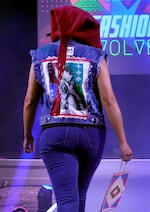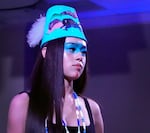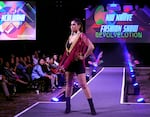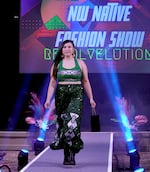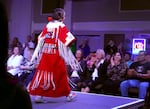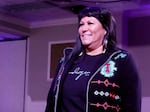The Wednesday night show hadn’t officially started, but the crowd was already starting to giggle in anticipation as the lights lowered at the event center at the Wildhorse Resort and Casino.

Casey Pearlman, left, and Jacob Wallis speak to the audience at the Northwest Native Fashion Show at the Wildhorse Resort and Casino in Mission, Ore., Oct. 4, 2023. The fashion show was part of the annual Northwest Native Economic Summit, a four-day event where attendees learned how to support and grow tribal small businesses.
Antonio Sierra / OPB
Thunder boomed over the sound system as the smoke machines whirred to life. A figure veiled in black walked the catwalk as a narrator talked about the people’s connection to the land and the work to preserve it for the next seven generations.
“We must assess our intention for mindful creation and destruction, for we are at the hands of both,” the narrator said.
Not long after, the model shed her veil to reveal a bright yellow two-piece outfit adorned with tribal jewelry. The 2023 Northwest Native Fashion Show on the Umatilla Indian Reservation had begun.
The brainchild of two Indigenous economic development officials, the fashion show was meant to spotlight Native designers who were looking to jump from the realm of hobbyist to professional fashion, their work incorporating the traditional artisanry of their tribes with more contemporary designs.
As a part of the larger Northwest Native Economic Summit, the fashion show was meant to be a part of a growing movement to support Native-owned small businesses.
And on Wednesday, that movement walked the catwalk.
‘Dedication to their craft’
The first inklings for the fashion show came when Jacob Wallis was young
A member of the Confederated Tribes of the Umatilla Indian Reservation with Yakama and Niimiipuu heritage, Wallis was given the Native name Watáy — summer ermine — by his grandmother. He remembered that his family often got together to make clothes for variety shows at their church.
Wallis said he still has VHS tapes showing the clothing made at these family gatherings, “department store” quality in his eyes. Some of those family members died before they could be recognized for their talents, he said.
“I’ve always felt kind of sad that they passed away (with) people not really knowing their work and their dedication to their craft,” he said. “I’ve always envisioned there being some type of platform that we can have for those creatives to be able to shine … more than just, ‘Oh, we just did it for a variety show in a backyard’ situation.”
Those plans solidified after he met Casey Pearlman. Both Wallis and Pearlman work in tribal economic development — Wallis as the business services manager for Nixyaawii Community Financial Services on the Umatilla Indian Reservation and Pearlman as the director of business development at the Affiliated Tribes of Northwest Indian Economic Development Corp. in Portland.
The pair were at a training summit in Portland last year and Pearlman had helped organize a reception at the Center for Native Arts and Cultures. Wallis found himself inspired by the space and quickly found an ally in Pearlman.
“He kind of sashayed across the room and he looked around,” Pearlman recalled. “He said, ‘Did you plan this?’ And I said, ‘Yep.’ He said, ‘Oh, this is great. We should do a fashion show in here.’ And seven months later, we had our first fashion show here in Wildhorse.”
The first show was planned on a tight timeline for a small audience. Intended to act as a reception for the business summit, the first fashion show brought in 75 people.
With more time to plan the second show, Wallis and Pearlman upped their ambition. This year’s event still coincided with the summit, but it was open to the general public and ticketed separately. Three hundred people attended.
Wallis was motivated to put on these shows because he wanted to demonstrate to Indigenous creators that their clothing and crafts didn’t just have cultural or personal value, but monetary value as well. Visitors bought dozens of items displayed on the runaway last year, Wallis said.
Pearlman said they were also intentional in the way they planned the event. Not only were the designers Native, but also the DJ, makeup artists and hair stylists. Many were from the Columbia plateau tribes: the CTUIR, the Confederated Tribes of Warm Springs, the Nez Perce Tribe and Yakama Nation.
“To put plateau designs made by plateau artists on a runway and for sale here, and just kind of model how these people deserve to be treated,” she said. “We’re happy to be that role model for the broader community.”
The pair can see the event expanding as a source of inspiration for other Native fashion shows on other reservations.
Wallis said the rise in Native designers and other tribal small businesses can be viewed as an expansion of tribal sovereignty.
“Our sovereignty has pretty much been limited to tribal enterprise and in tribal government, but we have so much more to develop. I think there’s been this level of hesitancy,” he said. “But the time is now and we’re making sure that we’re capitalizing on that.”
Self-reliance
Dave Tovey remembers when elders used to tell other tribal members that the Great Depression never reached the Umatilla Indian Reservation.
While many tribal members may not have had traditional employment, the director of Nixyaawii Community Financial Services said they still could rely on their traditions for subsistence and other needs. Tovey said his grandmother used to feed dozens of migrants who were traveling through Eastern Oregon looking for work.
As an economic development official who works for the CTUIR, Tovey said he’s looking to cultivate a similar spirit of self-reliance in the modern tribal economy.
“We need to make sure that, should the rest of the world fall apart, we still have a lot of the tools here to be self-reliant and keep our community safe and fed and secure,” he said.
Tovey is also the president of the Affiliated Tribes of Northwest Indian Economic Development Corp. and helped bring this year’s economic summit back to Wildhorse. He sees the fashion show as a natural extension of that spirit.
Nixyaawii provides both consumer and small business loans to tribal members, but he said much of the economy in Indian Country is still informal.
“I think there’s a lot of stuff that happens on the reservation that’s not a recorded economy. [It’s] a lot of trade and a lot of other things,” he said. “We’re at that point [where] we’re trying to help people identify those areas and help them along that route.”
When Wallis and Pearlman contacted potential designers for the show, many of them saw themselves as hobbyists rather than professionals.
A member of the CTUIR, designer Melinda Broncheau’s career got started out of necessity when she couldn’t afford to buy her children traditional clothing as a single mother. She relied on the traditions taught by her mother and grandmother and taught herself techniques if there was something she didn’t know.
“I think that mindset is a designer person,” she said. “If there’s something you want, and you put your own little spin on it, it’s your design now.”
With the help of Nixyaawii, she was able to open her own business, Ruby’s Indian Supplies and Crafts, during the COVID-19 pandemic.
Broncheau was excited to show off her wares at the fashion show Thursday, even if she didn’t want to bask in the spotlight. After the models finished showing off her clothes, she kept her curtain call brief as the audience serenaded her with applause.

